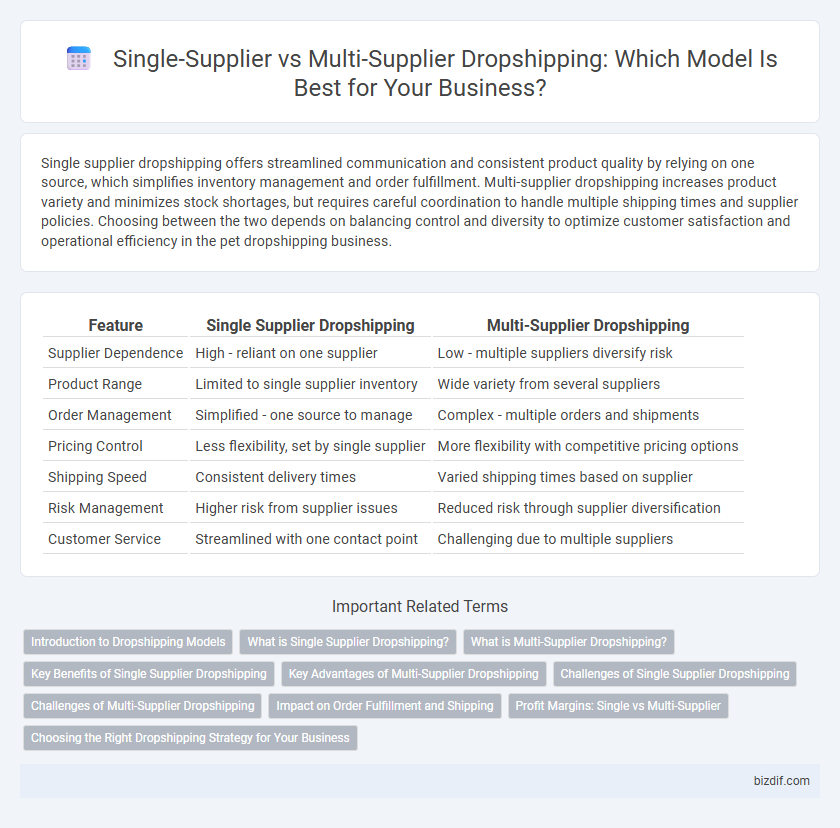Single supplier dropshipping offers streamlined communication and consistent product quality by relying on one source, which simplifies inventory management and order fulfillment. Multi-supplier dropshipping increases product variety and minimizes stock shortages, but requires careful coordination to handle multiple shipping times and supplier policies. Choosing between the two depends on balancing control and diversity to optimize customer satisfaction and operational efficiency in the pet dropshipping business.
Table of Comparison
| Feature | Single Supplier Dropshipping | Multi-Supplier Dropshipping |
|---|---|---|
| Supplier Dependence | High - reliant on one supplier | Low - multiple suppliers diversify risk |
| Product Range | Limited to single supplier inventory | Wide variety from several suppliers |
| Order Management | Simplified - one source to manage | Complex - multiple orders and shipments |
| Pricing Control | Less flexibility, set by single supplier | More flexibility with competitive pricing options |
| Shipping Speed | Consistent delivery times | Varied shipping times based on supplier |
| Risk Management | Higher risk from supplier issues | Reduced risk through supplier diversification |
| Customer Service | Streamlined with one contact point | Challenging due to multiple suppliers |
Introduction to Dropshipping Models
Single supplier dropshipping involves partnering with one supplier to streamline inventory management and ensure consistent product quality, which simplifies order fulfillment processes. Multi-supplier dropshipping allows access to a broader product range and reduces dependence on a single supplier but requires more complex coordination and inventory tracking. Choosing between these models impacts scalability, customer service efficiency, and risk management in the dropshipping business.
What is Single Supplier Dropshipping?
Single Supplier Dropshipping involves partnering with one supplier who manages inventory, order fulfillment, and shipping directly to customers, ensuring streamlined communication and consistent product quality. This model reduces complexity in supply chain management and helps maintain stronger relationships with the supplier. It is ideal for entrepreneurs seeking simplicity and reliability in their dropshipping business operations.
What is Multi-Supplier Dropshipping?
Multi-supplier dropshipping involves partnering with several suppliers to source products, allowing a wider inventory range and diversified risk. This model enables online retailers to offer various brands and products without holding stock, enhancing customer choice and reducing dependency on a single supplier's availability. Efficient inventory management and order synchronization are critical to handle multiple supplier integrations and maintain consistent fulfillment quality.
Key Benefits of Single Supplier Dropshipping
Single supplier dropshipping simplifies inventory management by centralizing product sourcing, reducing order errors and streamlining communication with one vendor. It enhances brand consistency and quality control, ensuring customers receive reliable products and faster fulfillment. This approach often results in stronger supplier relationships and potential cost savings through negotiated rates.
Key Advantages of Multi-Supplier Dropshipping
Multi-supplier dropshipping offers greater product variety and reduces dependency risk by sourcing inventory from multiple vendors, which enhances business resilience. It enables faster order fulfillment as suppliers can cover different geographic regions, improving customer satisfaction and delivery times. This model also provides increased negotiating power and flexibility in pricing, resulting in better profit margins and competitive advantage.
Challenges of Single Supplier Dropshipping
Single supplier dropshipping faces significant challenges such as dependency risk, where any disruption in the supplier's operations directly halts product availability and delays shipping times. Limited product variety can restrict market reach, reducing the potential for sales growth and customer retention compared to multi-supplier strategies. Furthermore, reliance on a single supplier often results in less negotiating power and increased vulnerability to price fluctuations.
Challenges of Multi-Supplier Dropshipping
Managing multi-supplier dropshipping involves complex inventory synchronization, increasing the risk of overselling or stockouts due to inconsistent real-time data. Coordinating order fulfillment across various suppliers also complicates logistics, leading to potential delays and customer dissatisfaction. Furthermore, the diversity of supplier policies can create challenges in maintaining uniform quality control and return processes.
Impact on Order Fulfillment and Shipping
Single supplier dropshipping streamlines order fulfillment by centralizing inventory and shipping processes, leading to faster shipping times and simplified tracking. Multi-supplier dropshipping offers product variety but can cause delays due to disparate shipping schedules and varying fulfillment standards. Efficient coordination in multi-supplier models is crucial to minimize shipping inconsistencies and maintain customer satisfaction.
Profit Margins: Single vs Multi-Supplier
Single supplier dropshipping often yields higher profit margins due to streamlined operations, bulk purchasing discounts, and consistent pricing from one source. Multi-supplier dropshipping can reduce profit margins since managing multiple suppliers increases administrative costs and may result in price variability. However, multi-supplier models offer diversified product ranges and risk mitigation, balancing margin fluctuations with inventory flexibility.
Choosing the Right Dropshipping Strategy for Your Business
Choosing the right dropshipping strategy requires evaluating the benefits of single supplier dropshipping, which offers streamlined inventory management and stronger supplier relationships, against multi-supplier dropshipping that provides product variety and reduced stockout risks. Businesses prioritizing control and consistent branding often favor single suppliers, while those targeting broad market coverage typically benefit from multiple suppliers. Assessing product niche, customer demand, and operational capacity ensures alignment with the optimal dropshipping model for scalability and profitability.
Single Supplier Dropshipping vs Multi-Supplier Dropshipping Infographic

 bizdif.com
bizdif.com